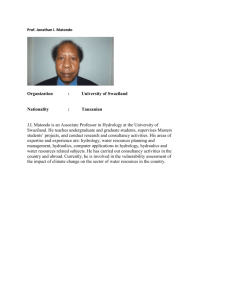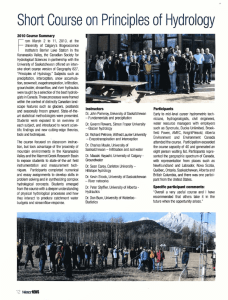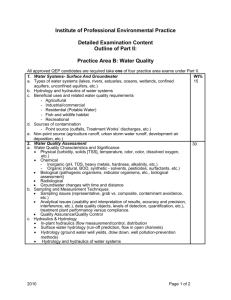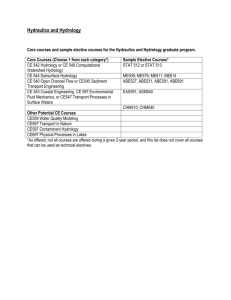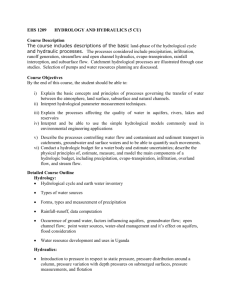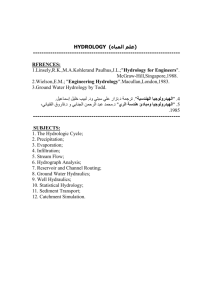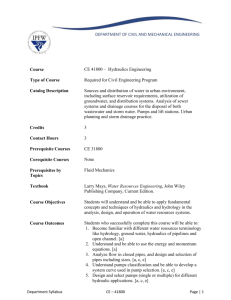Trail Bridges – A Common Sense Approach to Selecting Bridge Sites
advertisement
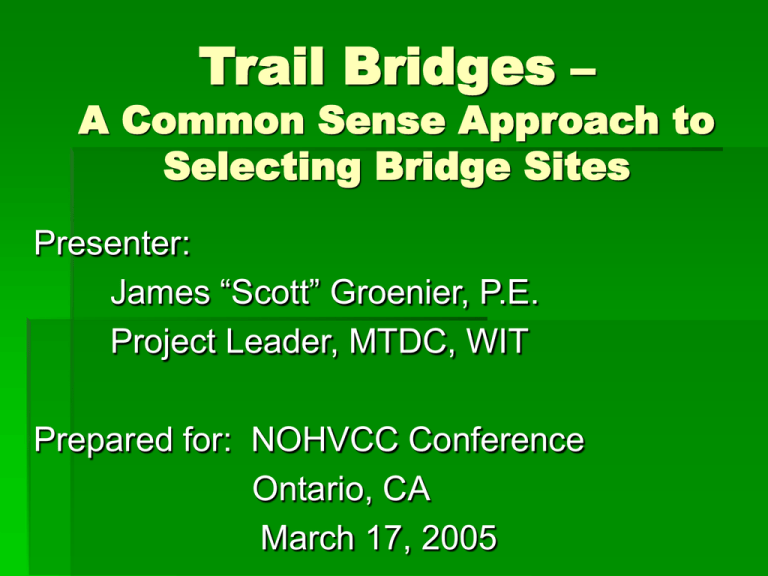
Trail Bridges – A Common Sense Approach to Selecting Bridge Sites Presenter: James “Scott” Groenier, P.E. Project Leader, MTDC, WIT Prepared for: NOHVCC Conference Ontario, CA March 17, 2005 Technology & Development Introduction Site Reconnaissance Geomorphology Concerns Hydrology and Hydraulics Alignment Environmental Concerns Design Loads Trail Bridge Website Summary 2 Technology & Development Site Reconnaissance Site Investigation - simple 3 Technology & Development Site Reconnaissance Site Investigation - Complex Streambed strata Floodplain widths Soil types Logs in stream Ice Damage Drift locations Etc 4 Technology & Development Site Reconnaissance Site Survey Center of Stream Edge of water Bottom of Bank Top of Bank Floodplains Trail Survey upstream and downstream for 300 ft Survey approaches on both sides 150 ft Survey top of banks for 30 ft Utilities Roads Drift / Ice damage Etc 5 Technology & Development Site Reconnaissance Geotechnical Investigation 6 Bedrock Loam Geomorphology Concerns Technology & Development From Rosgen’s “Field Guide for Stream Classification” 7 Technology & Development Geomorphology Concerns Stream Stability Deposition Area – Type C Channel Bedrock - Type A Channel 8 Stable Banks – Type B Channel Technology & Development Geomorphology Concerns Bank Stability 9 Technology & Development Hydrology and Hydraulics Waterway Adequacy Hydrology + Regression Equations from USGS Reports on Estimating Frequency and Magnitude of Floods = Flow (CFS) 10 Technology & Development Hydrology and Hydraulics Waterway Adequacy Hydraulics 1) Take CFS from Hydrology 2) Take Site Investigation info 3) Take Site Survey HEC-RAS Example And Use a computer model such as HEC-RAS (River Analysis System) Or WinXSPRO And you get this….. 11 Technology & Development Hydrology and Hydraulics Flooding –Spring, Fall or rain on snow Good or Bad Location? 12 Technology & Development Hydrology and Hydraulics Scour 13 Technology & Development Hydrology and Hydraulics Navigational Clearance 5 ft Minimum Required 14 Technology & Development Alignment Horizontal 90 degree Bend Straight 15 Technology & Development Alignment Vertical Bottom of Sag Curve Slight Grade 16 Technology & Development Environmental Concerns Fisheries Spawning Areas, Fish passage TES - Closures Salmon Bull Trout Cutthroat Trout etc Wildlife Nesting Trees, Rearing areas, etc TES - Closures Indiana Bat Bald Eagles Northern Goshawk etc 17 Technology & Development Environmental Concerns Ice Flow Floating Debris Falling Trees Falling Rocks Excessive Snow Loads Avalanche Chutes Springs/Seeps Wetlands Others 18 Technology & Development Design Loads Dead Loads Superstructure Decking Railing Wearing Surface Miscellaneous Utility Lines Covers 19 Technology & Development Design Loads Live Load Pedestrian – 85 psf Equestrian OHV’s Snowmobiles Mountain Bikes Vehicles 5,000 width <6 ft 10,000 6 ft<width<10 ft 20 Technology & Development Design Loads Snow Loads – 0 psf to over 350 psf SNOTEL sites – 550 to 600 in the West Local Building Officials http://fsweb.mtdc.wo.fs.fed.us/snow_load/ Wind Loads Overloads Groomers 7600# - 18,000# 21 Bridge Types Technology & Development Trail Bridge Catalog Forest Service Intranet http://fsweb.mtdc.wo.fs.fed.us/bridges/ Forest Service Internet http://www.fs.fed.us/na/wit/WITPages/bridgecatalog/ 22 Technology & Development Bridge Fabrication/Supply Structure produced by a certified Manufacturer for the type of material being used. - See “Contact Information For Wood and Steel Pedestrian and Trail Bridges” at National Wood In Transportation Website 23 Technology & Development Summary Site Reconnaissance Geomorphology Concerns Hydrology and Hydraulics Alignment Environmental Concerns Design Loads Trail Bridge Website Questions? 24
